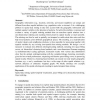Free Online Productivity Tools
i2Speak
i2Symbol
i2OCR
iTex2Img
iWeb2Print
iWeb2Shot
i2Type
iPdf2Split
iPdf2Merge
i2Bopomofo
i2Arabic
i2Style
i2Image
i2PDF
iLatex2Rtf
Sci2ools
JIIS
2006
2006
Spatial ordering and encoding for geographic data mining and visualization
: Geographic information (e.g., locations, networks, and nearest neighbors) are unique and different from other aspatial attributes (e.g., population, sales, or income). It is a challenging problem in spatial data mining to take into account both the geographic information and multiple aspatial variables in the detection of patterns. To tackle this problem, we present and evaluate a variety of spatial ordering methods that can transform spatial relations into a one-dimensional ordering and encoding which preserves spatial locality as much possible. The ordering can then be used to spatially sort temporal or multivariate data series and thus help reveal patterns across different geographical spaces. The encoding, as a materialization of spatial clusters and neighboring relations, is then amenable for processing together with aspatial variables by any existing (non-spatial) data mining methods. We design a set of measures to evaluate nine different ordering/encoding methods, including tw...
| Added | 13 Dec 2010 |
| Updated | 13 Dec 2010 |
| Type | Journal |
| Year | 2006 |
| Where | JIIS |
| Authors | Diansheng Guo, Mark Gahegan |
Comments (0)

